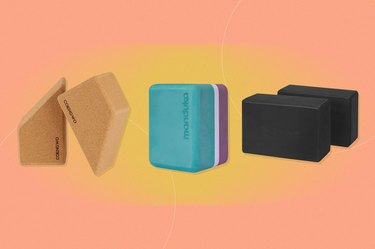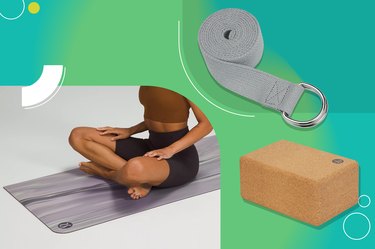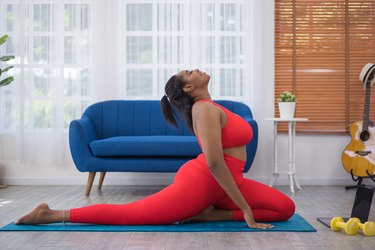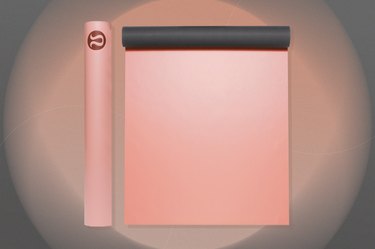

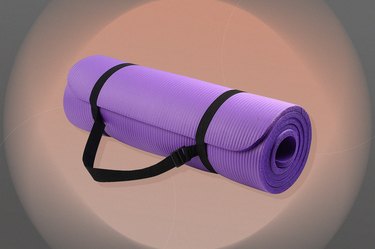

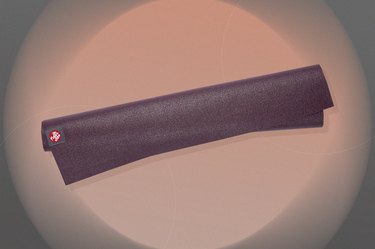

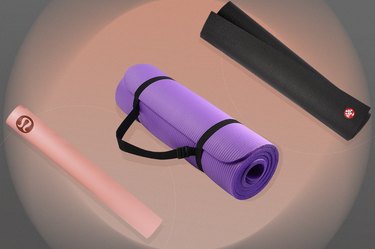

You can do downward-facing dog on the grass or child's pose on the floor to get your flow on, but doing it on a yoga mat is a welcome alternative, especially if you have sensitive joints.
And you don't only have to use it for breaking out into crow pose. The best yoga mats are those you can use for a variety of asanas, so consider what your practice demand.
Video of the Day
Video of the Day
For example, if you do a lot of hot yoga and HIIT, you may want a mat with quick-drying, grippy material. Or if you prefer a more restorative class with lots of lying-down poses, you may want to prioritize a thicker mat.
Here are our recommendations for the best yoga mats, plus, what other features you should consider before purchasing.
How We Chose
To help you make a smart choice, we rounded up these five best yoga mats based on recommendations from Kells McPhillips, a certified yoga instructor. We chose these products based on criteria including:
- Size/thickness
- Material
- Other features offered
1. Best Overall: Lululemon Reversible Mat 3mm
- Material: polyurethane, natural rubber, synthetic rubber, polyester and nylon
- Thickness: 3mm
- Best-selling feature: reversible
It's hard to compete with lululemon's yoga products, especially this reversible mat, according to McPhillips. This mat has a polyurethane top coating, which provides your hands and feet an excellent grip.
Whether you're doing a Vinyasa flow or a bunch of burpees, you have the option to switch sides of your mat. This reversible mat also has an antimicrobial treatment that helps keep odor-causing bacteria and mildew at bay after sweaty workouts.
Buy it: lululemon.com; Price: $68 to $78
2. Best Cushioning: Manduka Pro Yoga Mat 6mm
- Material: OEKO-TEX-certified PVC
- Thickness: 6mm
- Best-selling feature: extra cushioning
The best part about this Manduka mat is the thickness, according to McPhillips. In most yoga classes, you'll spend some time kneeling, which is where the 6-millimeter thickness really comes in handy.
"I especially love this one for people who have joint sensitivity," McPhillips says. "The thickness offers a little extra support and cushion." Plus, the mat's dotted texture helps keep it in place and helping prevent slips.
Buy it: Manduka.com; Price: $129
3. Best Budget-Friendly: BalanceFrom GoYoga All-Purpose 1/2-Inch Extra Thick Mat
- Material: high-density foam
- Thickness: 12mm
- Best-selling feature: double-sided, non-slip surfaces
Despite its heavy-duty thickness, this BalanceFrom mat is extremely lightweight and even comes with a strap. It's also moisture-resistant and can be cleaned with soap and water. And at a super-affordable price point, you can't go wrong.
McPhillips recommends this mat for beginner yogis or someone who's looking for a basic stretching mat. Pro tip: You can layer a thin polyurethane mat or yoga towel on top to give yourself a little more grip.
Buy it: Amazon.com; Price: $19.47
4. Best for Sustainability: Jade Harmony Professional Yoga Mat
- Material: natural rubber
- Thickness: 5mm
- Best-selling feature: slip-resistant
Jade Harmony mats are widely beloved for their sustainable materials, according to McPhillips. This yoga mat is made of natural rubber from renewable rubber trees, and it's free of PVC and other environmentally harmful materials.
Not to mention, natural rubber makes the perfect non-slip surface even during a sweaty hot yoga class, she says. And because it has a 5-millimeter thickness, it provides just enough comfortable cushioning.
Buy it: REI.com; Price: $84.95
5. Best for Travel: Manduka EKO Superlite Travel Yoga Mat 1.5mm
- Material: 100-percent non-Amazon tree rubber
- Thickness: 1.5 mm
- Best-selling feature: easily foldable
When you're running from a yoga class to the office, this lightweight mat is your best friend, according to McPhillips. This mat is perfect for any kind of travel, because you can easily fold it into a neat, little square to save space in your bag or suitcase.
The bottom also has a grippy surface, so it stays put — no matter how intense your workout is. What's more, the open-cell surface prevents sweat from absorbing, so you won't have to worry about stashing a soggy mat in your bag.
Buy it: Manduka.com; Price: $49
3 Tips for Buying the Best Yoga Mats
1. Prioritize Material
Investing in a yoga mat made of grippy material is game-changing, McPhillips says. You never want to feel like you're about to fall or slip during a yoga class, especially as you transition into more challenging poses, like camel or a handstand.
That's why you want to look for a yoga mat made of non-slip materials, such as polyurethane. Polyurethane is a type of plastic that's usually a top coating on high-end yoga mats. It provides comfort and is easy to grip, making your hands and feet feel like they're firmly rooted into the mat. Polyurethane is also durable, helping your mat last for years, McPhillips adds.
2. Find the Right Thickness
Thickness is a personal preference, which is why you want to try out different yoga mats before you buy one, McPhillips says. Thicker mats (6 millimeters and above) are excellent for people who have sensitive joints, as they provide extra support and cushioning.
McPhillips suggests yoga newbies start with a 3-millimeter or 5-millimeter mat, which is the standard thickness. This level of thickness provides padding without it feeling too squishy during your practice.
With that said, thicker mats are usually more expensive. And if you're shopping on a budget, McPhillips recommends buying a thin polyurethane mat (like the 1.5-millimeter mat above) and layering it on top of a communal mat at your yoga studio or gym.
3. Choose a Design Wisely
Although bright colors on a mat are fun and festive, they can get dirty or tiresome after a while, McPhillips says. Ideally, the yoga mat you buy lasts for several years at a time. So look for a color and design that stays clean and looks simple.
"Don't get a color you're going to fall out of love with very quickly," she says. "I just have a simple black mat, because I know I'll get sick of every other color."
